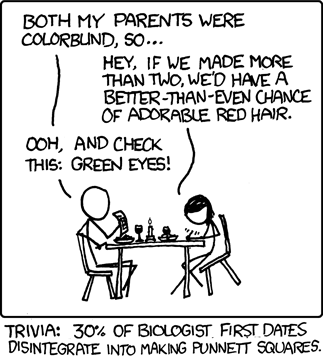634: Date
| Date |
 Title text: Well, the kid's definitely getting the biology geek phenotype. |
Explanation[edit]
Cueball and Megan (as biologists) are on a first date. As opposed to the usual romantic talk or discussion about each other's histories or character, the comic suggests that 30% of the time, two biologists on a first date will end up making Punnett squares, which non-biologists might not consider very interesting or romantic.[citation needed] The comic may be a play on the idea that couples on a first date might wonder about (or on a very promising date, even discuss) the traits in the other person that might be passed on to potential children.
A Punnett square is a simple diagram used in biology to determine the probable resulting genotype of cross-breeding two organisms, be they plant or animal (including humans). The diagram shows all possible results of crossing a single genotype from each parent in the offspring genotype following Mendelian inheritance.
For humans and most animals, there are two alleles for each gene, and each parent passes one of their alleles for each gene on to the offspring. The most simple Punnett square is a 2x2 table with a legend of the two paternal alleles on one axis (e.g.: A and A) and the two maternal alleles on the other axis (e.g.: A and a). Each box of the Punnett square represents a possible genetic outcome as a result of each each of the alleles being passed on to the offspring (AA, Aa, AA and Aa). For certain genetic traits, one genotype may determine a specific trait in the offspring; e.g. black hair in rats. Certain genotypes have dominant and recessive alleles. An offspring must have both of the recessive alleles to display the recessive trait; in the above example, if "a" was an allele for a recessive trait, the offspring could not have the recessive trait, as there is no possible aa outcome. This is the basic principles that allows statements to be made that two parents with a certain blood type or eye color could not possibly have an offspring with a certain other blood type or eye color.
More complicated Punnett squares can factor in multiple genes and be larger in scale, but ultimately follow the same principle. The premise for the purposes of the comic is that by using Punnett squares, one can assess the likelihood of certain genetic traits (such as hair color or color blindness) in their offspring with another person. One would have to know their genetic makeup in general for this to be possible.
While a genotype refers to the genetic makeup of an organism, a phenotype as referenced in the title text refers to the resulting traits (e.g.: Red hair is a phenotype).
The traits mentioned by Cueball and Megan are all genetic traits which can be traced using Punnett squares. That said, at least two of the traits (green eyes and color blindness) are not traits determined by a simple single-gene interaction. Color blindness can be inherited, although there are a significant number of genes that can factor into various types of color blindness. Red green color blindness, the most common variety, is sex linked to the X chromosome. Because of the way X chromosomes are passed, if Cueball's mother was colorblind then Cueball would be, though his faulty X chromosome could only be passed to a daughter who would need another faulty X from her mother to inherent colorblindness. Once thought to have fairly simple genetic factors, eye color is now known to be a factor of at least 15 different genes with almost any parent-child combination possible. Red hair is still believed to be a recessive trait associated with a small number of genes (perhaps even one gene), although other traits once thought to be determined by only one gene have since been proven otherwise.
The title text mentions how a child with Megan and Cueball as their parents would almost certainly grow up to share the same interest in biology as both of their parents. Although a child would share certain traits with their parents, either ones that are genetic or ones picked up in their respective childhoods spent with their parents, the claim made in the title text is not guaranteed to become true as a child would most likely differ from their parents in some way or another, due to factors such as different life experiences and a different background that the child grew up in compared to their parents.
Transcript[edit]
- [Two people are sitting at a table, with a candle-lit dinner. Cueball is holding up a sheet of paper depicting a Punnett square, and Megan is scribbling.]
- Cueball: Both my parents were colorblind, so...
- Megan: Hey, if we made more than two, we'd have a better-than-even chance of adorable red hair.
- Cueball: Ooh, and check this: green eyes!
- Trivia: 30% of biologist first dates disintegrate into making Punnett squares.
